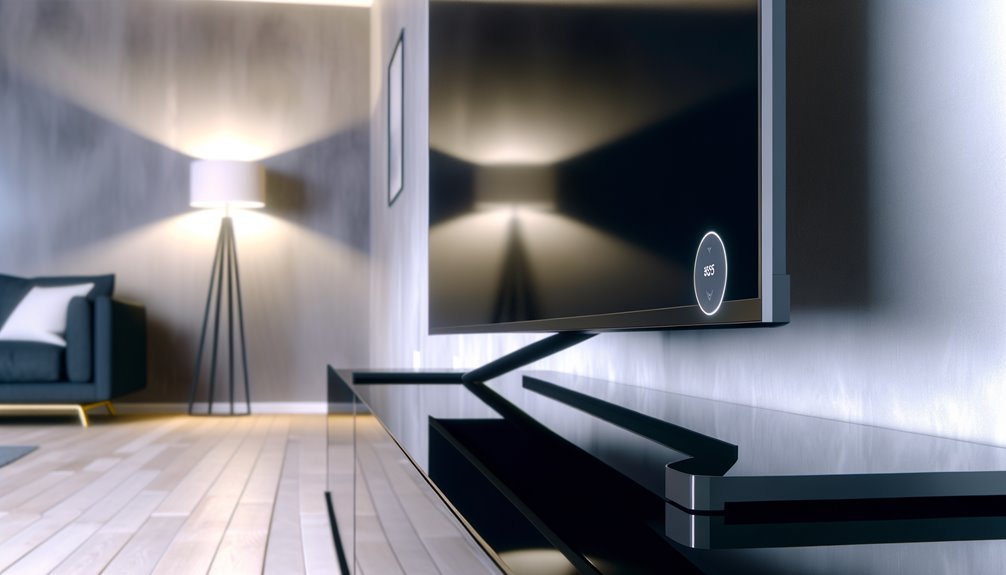To set up your Freesat satellite system, begin by aligning your dish to the correct azimuth angle using a compass.
Confirm that the dish’s elevation avoids any obstructions like trees or buildings.
Properly align your LNB to match the satellite’s specifications, such as frequencies and polarisations.
Consider upgrading to a Quad LNB for better signal reception and more flexibility. Verify that the path between your dish and the satellite is clear from obstacles.
Fine-tuning and precise adjustments will optimise signal strength and ensure uninterrupted TV broadcasts.
For a deeper understanding of each step, continue exploring detailed instructions.
Key Information
- Align the dish to the azimuth angle specific to Freesat’s satellite position.
- Ensure the LNB is correctly configured and compatible with Freesat’s frequencies and polarisations.
- Avoid obstructions like trees and buildings for optimal signal strength.
- Fine-tune the dish elevation and azimuth to secure the best reception.
- Upgrade to a Quad LNB for enhanced signal quality and multiple channel access.
- If you require TV wall mounting, simply click the “Book Now” button and follow the steps to secure your appointment.
Aligning Your Satellite Dish
To guarantee peak signal reception, start by accurately aligning your satellite dish to the correct azimuth angle specified for Freesat services.
Make sure you’re aware of the specific satellite locations and frequencies for precise alignment.
Adjust the dish elevation to avoid obstructions like trees and buildings that can weaken TV signals.
It’s helpful to consult neighbors’ dish alignments as a reference, but remember that individual factors might impact signal strength differently.
Additionally, ensure your LNB (Low-Noise Block downconverter) is fitted correctly and aligned with the azimuth angle.
A properly positioned LNB greatly enhances TV signal quality.
Adjusting the Azimuth Angle
Aligning your satellite dish to the correct azimuth angle is essential for peak signal reception, ensuring you receive a clear and uninterrupted TV broadcast.
To achieve ideal alignment, follow these steps:
- Determine Satellite Position:
Identify the satellite you need to align with, such as Astra 2 (28.2E) or Hotbird (13E). Use a satellite finder tool for precision.
- Set Azimuth Angle:
Use a compass to set the dish’s azimuth angle. For example, Astra 2 requires 28.2 degrees east of true north.
- Fine-Tuning:
Slowly adjust the dish left and right, monitoring signal strength until you reach the highest possible reading.
Avoiding Obstructions
Ensuring best signal reception requires positioning your satellite dish where it won’t be obstructed by objects like trees, buildings, or other structures.
Adjust the dish’s elevation strategically to prevent interference from nearby obstacles.
Clear the path between the transmitter and receiver, ensuring no barriers like branches or walls block the signal.
Removing any obstructions directly in front of the dish will greatly improve signal strength and reception quality.
Proper alignment is vital; make sure the dish is pointed correctly to maintain ideal TV signal quality.
Setting the dish at an appropriate height will also minimise interference, providing a stronger, more reliable signal.
Always check for potential obstructions before finalising the dish’s position.
Checking LNB Configuration
Confirm your LNB’s compatibility with your satellite service provider’s specifications to guarantee the best possible channel reception.
Ensuring the right configuration involves several steps:
- Verify Frequencies and Polarisations: Match your LNB to the specific frequencies and polarisations used by your satellite service. This alignment is essential for clear reception.
- Proper Alignment: Adjust your LNB to align it precisely with your satellite dish. This step maximises signal strength and clarity.
- Consult Guidelines: Refer to your satellite service provider’s guidelines or consult a professional installer. They can confirm that your LNB is set up correctly for optimal performance.
Following these steps ensures your LNB is correctly configured, providing you with the best possible satellite TV experience.
Upgrading to a Quad LNB
After verifying that your LNB is properly configured, you might consider upgrading to a Quad LNB to enhance signal reception and expand your access to free-to-air channels.
A Quad LNB allows for better signal reception by supporting multiple modes, improving transmission quality.
It’s compatible with various satellites, increasing the range of channels you can receive.
Installing a Quad LNB optimises your satellite dish system, signaling up to four different modes for flexibility and performance.
This upgrade can resolve channel reception issues, guaranteeing you receive a broader spectrum of content.
When selecting a Quad LNB, make sure it’s designed for your specific satellite system to maximise its benefits and improve overall signal efficiency.
General Tips for Setup
Properly aligning your satellite dish is essential for achieving the best signal reception. Start by adjusting the dish elevation to avoid obstructions like trees and buildings.
Use your neighbors’ dish alignment as a reference point to guide your setup.
Ensuring your LNB is correctly fitted is vital for optimising signal quality. Here are some key tips to follow:
- Check for Obstructions: Make sure the dish has a clear line of sight; even small obstructions can impact signal strength.
- Secure the Dish: Ensure your satellite dish is firmly mounted to prevent misalignment due to wind or other factors.
- Safety First: Always use proper safety gear and precautions when working at heights to avoid accidents.
Follow these steps for a successful setup.
Frequently Asked Questions
Which Satellite Does Freesat Use in the UK?
Freesat in the UK uses the Astra 2 satellites located at 28.2 degrees East. You need to align your satellite dish accurately to these satellites to guarantee excellent reception and access to over 200 TV and radio channels.
How Do I Get to Freesat Settings?
To access the settings, go to the TV or set-top box menu. Navigate to the satellite dish installation or setup section. Adjust parameters like frequency and polarisation there. Confirm that your dish correctly aligns with Astra 2 Satellites at 28.2E.
Why Is My Freesat Satellite Dish Not Getting Signal?
Make sure the satellite dish is correctly aligned and not obstructed. Check that the LNB is properly fitted. Verify all cable connections and inspect them for damage. If problems persist, consult a professional for precise dish realignment.
How to Realign Satellite Dish in the UK?
To realign your satellite dish in the UK, adjust it towards Astra 2 at 28.2E. Confirm there are no obstructions and fine-tune the azimuth angle and LNB skew for best signal quality.
Conclusion
To optimise your Freesat experience, make sure your satellite dish is correctly aligned and accurately adjust the azimuth angle.
Clear any obstructions and verify the LNB configuration. Consider upgrading to a quad LNB for better performance.
By following these detailed steps, you’ll maximise signal strength and picture quality.
Remember, meticulous setup is key—double-check all settings for the best results.
With these tips, you’re on your way to seamless satellite TV viewing.
If you require TV wall mounting, simply click the “Book Now” button and follow the steps to secure your appointment.



